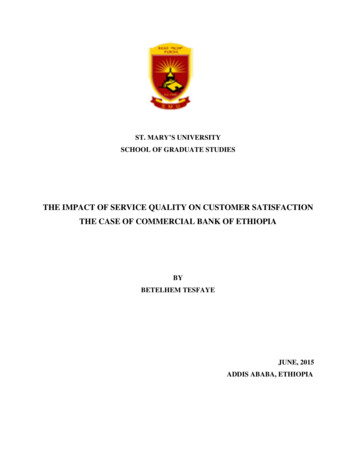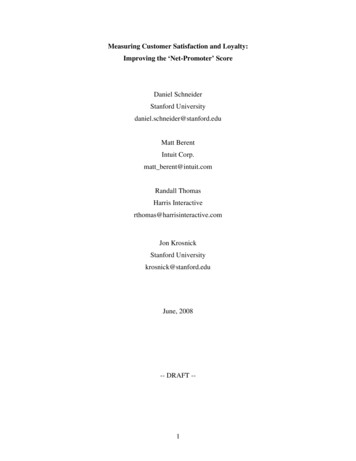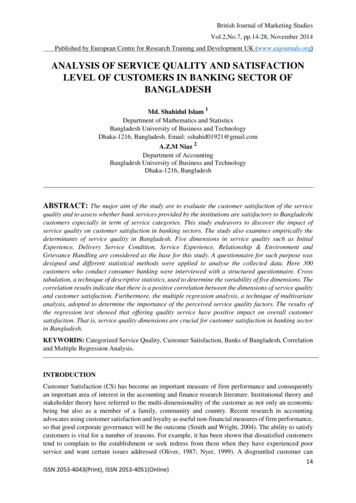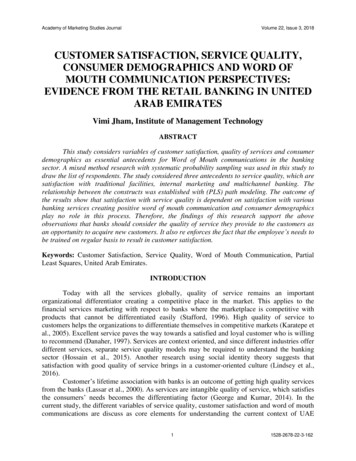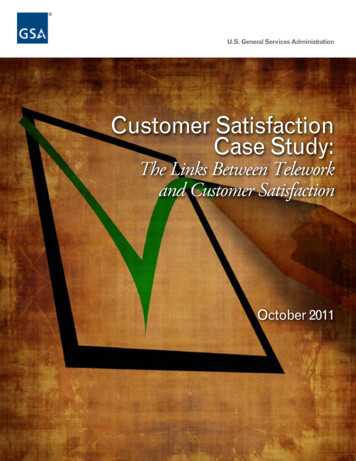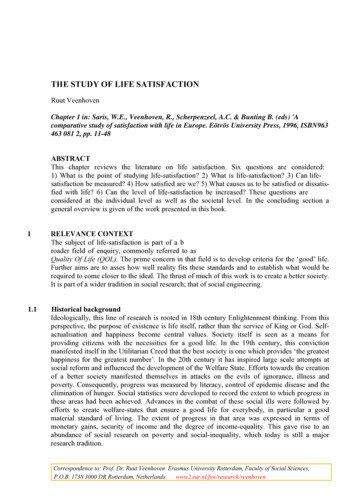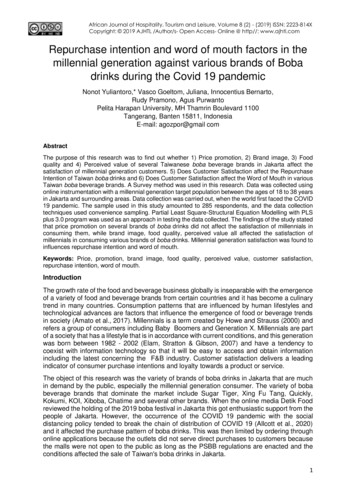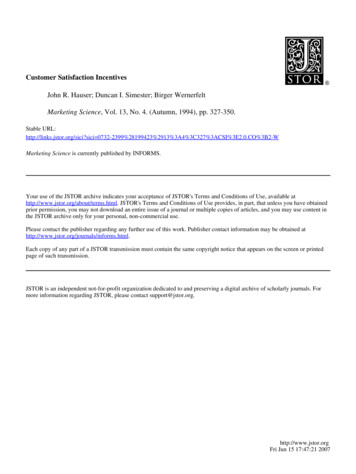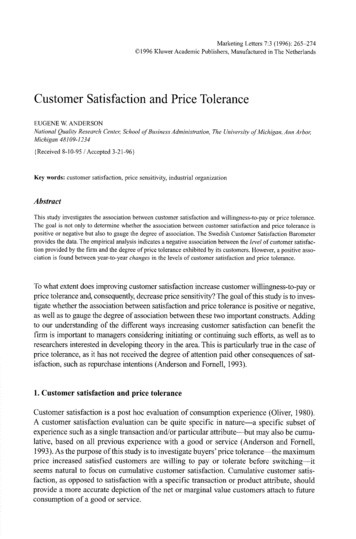
Transcription
Peter PalmLecturer Malmö UniversityUrban studiesMalmö University205 06 MalmöSwedenpeter.palm@mah.se 4640-665 77 11Measuring Customer Satisfaction:A Study of the Swedish Commercial Real Estate IndustryAbstractPurpose – The aim is to identify the strategies of formal customer evaluations and the use ofSatisfied Customer Index in the Swedish commercial real estate industry.Design/methodology/approach – This research is based on an inventory of twenty-fourcommercial real estate companies use of formal customer evaluations and an analysis offifteen interviews with top-level managers in the Swedish commercial real estate sector.Findings – Only half of the companies included in the study conduct formal evaluations,although they are considered to work customer oriented. Two different strategies for usingformal evaluations is, for improvement work and for signalling quality. One proposedexplanation to why only half of the companies conduct formal evaluations is the possibilitythat the official Swedish Real Estate Barometer is not sufficient if the company would like touse the result for organisational development. There are instead indications that thisBarometer mainly is used in publicity and marketing purpose, to signal quality.Research limitations/implications – The research in this paper is limited to Swedishcommercial real estate sector. But, the overall strategies for conducting formal evaluationsshould be applicable in general.Practical implications – The insight the paper provides regarding how the industry perceivethe Swedish Real Estate Barometer gives direct implications of improvements of thebarometer.Originality/value – It provides an insight regarding the use of formal customer evaluationsand a proposition of how the Swedish Real Estate Barometer could be changed to bettersupport and fulfils the aim of being a barometer for benchmarking.Keywords – Commercial Real Estate, Customer Relations, Customer Evaluation, Quality inReal Estate Management,Paper type Research paper1. IntroductionOrganisations approach customer satisfaction in various ways when managing and improvingtheir relationships with customers (Sandblad, 2007 and Gilbert & Veloutsou, 2006). In thepast decade, work involving customer satisfaction has received a great deal of attention(Kärnä et al., 2009) as the real estate industry becomes more competitive and part of anincreasingly dynamic environment (Lind & Lundström, 2011 and Phillips & Roper, 2009).Anderson and Sullivan (1993) emphasize that customer satisfaction is crucial for a companyto be competitive and profitable (see also Sanderson, 2014). Initially, investing in customerrelations to achieve customer satisfaction may be deemed (see Westlund et al., 2005) an
unnecessary expense, but it will likely become cost-effective in time and have a positiveimpact on profitability. The driving force behind this investment appears to be the goal of agood reputation and more positive word-of-mouth from customers. Kristensen and Westlund(2004) conclude that these should be followed-up and measured to achieve better businessresults. In line with this, Gale (1994) concludes in his book Managing Customer Value thatcompanies need a comprehensive strategic navigation system to provide data on bothfinancial and customer value performance.Kärnä et al. (2009) state that measuring customer satisfaction has several benefits fororganisations: improved communication, recognition of demand, better understanding ofproblems, evaluation of progress as well as the monitoring and reporting of accomplishedresults and changes. Several researchers also advocate that it has a strong positive impact onboth returns for the company (Westlund et al., 2005) and for shareholders (Aksoy et al.,2008). Tuli and Bharadwaj (2009) also claim that disclosing the customer satisfaction rate inan annual report has a positive impact on a stock’s risk determination. Research points at theimportance of monitoring, measuring, and evaluating customer relationships and satisfactionto gain a strategic advantage over competitors. These aspects are all well documented, butwhat about the actors? What is the underlying motive of the companies? This side of thecommercial real estate industry is not as well researched.This article aims to identify the strategies of formal customer evaluations and the use of theSatisfied Customer Index within the Swedish commercial real estate industry1.Sweden has a tradition of measuring customer satisfaction; in fact, Sweden was the firstcountry to establish a national indicator for customer satisfaction (Fornell, 1992). Thistradition makes it even more interesting to research the Swedish commercial real estateindustry and explore the strategies of companies regarding formal customer evaluations andthe use of the Satisfied Customer Index (SCI). Furthermore, conducting formal customerevaluations and/or participating in the Swedish Real Estate Barometer (SREB) can be a wayto work with and develop a service concept. It can also be a way to compare a company withother companies’ results and also within the organisation. Previous studies show that the realestate industry has developed to become more service and customer oriented (Phillips andRoper, 2009 and Palm, 2013). This implies that measuring customer satisfaction should be ofgreat interest for the industry. Addressing this question first constitutes an elaboration of whatcustomer satisfaction is and the relation to real estate management, before we can outline theconcept of measuring customer satisfaction.2. Customer satisfaction and orientation in real estate managementThis section is divided into two parts. The first part contains a general discussion regardingcustomer satisfaction, the definition of customer satisfaction, and an outline of the importanceof working with customer satisfaction. The second part discusses customer satisfaction in thecontext of real estate management.2.1 Customer satisfactionCustomer satisfaction has long been regarded as important within the management field (Laiet al., 2003). This attention is because high customer satisfaction has many benefits for the1Commercial real estate industry is defined according to Lind and Lundström (2011) to be thepart of the industry not focused on residential real estate.
firm. Fornell (1992) concludes that high customer satisfaction enhances the firm’s reputation,increases customer loyalty, and lowers the cost of future transactions.Several researchers (see Grönroos, 2008 and Appel-Meulenbroek, 2008) have recentlyemphasized that a company’s good reputation quickly translates into market shares andprofits. In research involving twelve different sectors, Reichheld (1996) shows that theretention of five percent more customers increases profit up to forty percent in office buildingmanagement. An effective customer relationship can do more than simply build on internalplans regarding customer relations. Payne and Clark (1995) state the following:The adaptation of the relationship philosophy as a key strategy issueis more important than a written plan. For example, a formalmarketing plan for internal markets is of little value if customercontact staff are not motivated and empowered to deliver the levelof service quality required. (Payne and Clark, 1995, p. 322)Current literature (see, for example, KärnäGee, Coates & Nicholson, 20084 or Grönroos,2008) confirms that customer satisfaction is a function of perceived quality anddisconfirmation; it is always the market’s perception of the service compared to thecompetitors which determines quality (Gale, 1994). At the same time, service quality is not adistinct factor nor an indistinct concept (Zineldin, 2006), but rather as defined by Grönroos(2008), what customers think is quality, and the quality of a service can only be as high as thecustomer perceives it. It is always the market s perception of the service compared to thecompetitors which determines quality and thereby difficult to examine as stated by Gallarza,Gil-Saura and Holbrook (2011). As service has been defined as a perception of the customer,we can now examine service in the context of real estate management.2.2 Customer satisfaction in the context of real estate managementUnlike manufacturing and certain service industries, the real estate sector is not simply sellingproducts and services; it involves a much more diverse service relationship with long-termcontracts as well as “selling” their reputation in both contact with their customers and withtheir customer’s buyer. This is important because the commercial real estate market isdemand-driven, as Appel-Meulenbroek (2008) states. Li (2003) and Matzler and Hinterhuber(1998) conclude that the cost of attracting new customers is much higher than for keepingcurrent customers. Focusing on current customers’ needs can be rewarding; therefore, the realestate industry concentrates on retaining their customers instead of attracting new tenants.Pinder et al. (2003) also stress the importance of tenants and the rewards of treating them asvalued customers.As the real estate industry realizes the importance of customers, so too have the customersbecome more demanding concerning the services delivered. Baharum et al. (2009) claim thattenants today are more aware of the level of service they receive. Moreover, commercialbuildings have become more complex with high-level technology requiring highlyknowledgeable managers (Chin and Poh, 1999). This is a complex situation for the real estatemanager who must meet the demands of high-level technology and satisfy customersexpecting high-quality service. In fact, Lindholm (2008) believes level of service is the mostessential task for a manager and that improving service and the service relationship should beamongst a property manager’s top priorities.
Kärnä (2004) discusses the importance of delivering good service to render customersatisfaction and concludes that customer satisfaction leads to a stronger relationship betweencustomer and company. Further, Jones and Sasser (1995) believe that customer satisfaction isthe key to securing customer loyalty and long-term relationships. According to Storbacka etal. (1994), long-term relationships with customers are profitable for both customer andcompany (provider) and are essential in the real estate industry because of the long-termcontracts and high transaction costs.Appel-Meulenbroek (2008) believes that retaining tenants requires more efforts inmaintaining a good relationship than competing through simply offering a good price/qualityratio. The valuation process of certain “keep” factors is mainly subjective from the tenants’side. Also, “push and pull” factors, which are mainly technical, can only raise satisfaction to acertain extent. On the other hand, the “keep” factors, which are mostly functional, areessential in retaining tenants given that satisfied tenants are more likely to feel a sense ofcommitment to the landlord and remain in the commercial space (Dogge and Smeets, 2004).Also Sandersson (2015) conclude that the aspects with most impact on tenants satisfactionwith property management are communication and understanding of the tenants needs.3. Measuring customer satisfactionThis section is divided into two parts. In the first part, a general description of measuringcustomer satisfaction is given, and the arguments, for performing this kind of formalevaluation, are also discussed. In the second part, the Swedish Real Estate Barometer (SREB)is described and outlined.3.1 Measuring customer satisfactionAs concluded in previous sections, the importance of customer satisfaction is clearly wellknown both in general and also within real estate management. This recognition has promptedvarious companies to conduct customer satisfaction evaluations. Outside companies alsosupply specific indexes (barometers) which serve the real estate industry. This relates to Gale(1994) who concludes that companies need a strategic system to provide data on customervalue performance. A conclusion that goes well in hand with the attention the industry givesto formal customer evaluations; however, when it comes to measuring customer satisfaction,there is no generally accepted standard of how to conduct this measurement (Gilbert andVeloutsou, 2006).Several variants of how to measure customer satisfaction are currently in use (Eboli andMazzulla, 2009). In current literature about customer satisfaction, the three most exploredmethods are the expectancy–disconfirmation paradigm, the perceived performance paradigm,and the view of cumulative satisfaction (Johnson et al., 2001). All three paradigms have theirown strengths and weaknesses, but the main difference lies between the first two. Theexpectancy–disconfirmation paradigm takes the expectations of the customer intoconsideration, whereas the other two do not. Also, the cumulative satisfaction paradigm takesinto consideration the prior experience of the customer, which serves as a cognitive anchor(Johnson et al., 2001). Even if all tests do not measure the customer’s expectations and/orexperience, it is recognized as an influence on the customer’s perception of the quality of theservice delivered.As Grönroos (2008) also concludes, the quality of the service is always based on thecustomer’s expectations and/or experience. Parasuraman et al. (1985) take it one step further,
stating the quality evaluation is not solely based on the outcome of a service; the process ofthe service delivery is taken in account as well. At the same time, simply accommodating thetenant’s specific needs can influence retention equity—needs which customers often finddifficult to articulate (Pinder et al., 2003), making the evaluation of customer satisfactiondifficult. This difficulty in taking everything into consideration when designing the evaluationand measuring customer satisfaction is one of the main arguments for the perceivedperformance evaluations (Johnson et al., 2001).Current literature highlights the importance of measuring customer satisfaction in real estatemanagement (see, for example, Baharum et al., 2009, Palm, 2008 and Chin and Poh, 1999).To remain competitive, real estate companies must listen and respond to their tenants’ needsand expectations (Chin and Poh, 1999). A study of the use of formal evaluations in real estatemanagement in Sweden (Palm, 2008) reveals that the evaluations seldom start with thetenants’ needs a reflection shared with Baharum et al. (2009) who also conclude that propertymanagers tend to focus only on variables which can easily be translated into cost reduction.In general, the measurement of customer satisfaction is considered a post-consumptionassessment by the user regarding the service provided (Gilbert and Veloutsou, 2006).However, in the real estate industry, the measurement is conducted during the ongoing servicedelivery with the tenants still contracted, making this situation quite unique. This helps theindustry collect the best material because it is generally observed that the sooner theassessment is done to the actual service delivery, the more correct the assessment of thequality. However, Mittal et al. (1999) argue that the sooner the customer’s evaluation isconducted relative to the time of service also means the most recent customer contact mayinfluence the customer’s overall rating. This implies a risk for bias if the customer has had aparticularly good or bad service experience closer to the time of the evaluation.3.2 The Swedish Real Estate BarometerThe Swedish Real Estate Barometer (SREB) is based upon a survey conducted with tenants tothe participating real estate company. For every participating real estate company the surveyis distributed to up to 100 tenants, randomly selected (i.e. all of the companies’ tenants arenever included). It was founded in 1995 as a subdivision of the Swedish CustomerSatisfaction Barometer (SCSB). The SREB (and SCSB) takes as its foundation the perceivedperformance paradigm and does not measure/test for customer expectations.The survey is distributed by post or electronically through the Internet. To secure the responserate, two reminders are distributed if necessary. The survey is conducted yearly, and the topthree companies with the highest overall score are presented; however, companies with alower score can also be presented if they so desire. All the companies get a report of resultsalong with the possibility to have an analysis conducted. This benchmarks the companyagainst the industry as a whole while, at the same time, enabling them to do internal revising.4. Research design and methodologyThis article is based on a study of twenty-four original companies’ annual reports and aninterview study with fifteen top-level managers from those twenty-four companies. Thetwenty-four companies were selected by using the same companies Palm (2011) used. Thismeans being able to refer to Palm’s categorisation of the companies as either customer,project, financial, or brick oriented. All of these companies are real estate companies, whichown and manage commercial premises (no residential companies were included). First, the
research for this article involved checking if these twenty-four companies participated inSREB and/or make formal customer evaluations. Second, an interview study was conductedwith top-level managers from fifteen of the twenty-four companies. The aim of the interviewstudy was to identify top management’s motives for whether or not to measure customersatisfaction.4.1 Data collectionThe respondents interviewed are all top managers from fifteen real estate companies. Asdefined by Patton (2002) and Eisenhardts (1989), the selection is a stratified, purposefulsample made to include a wide range of commercial real estate firms representing companieswho conduct formal evaluations, as well as companies that do not, with all falling into fourcategories (as defined in Palm, 2011): customer, project, financial and brick oriented. Theselection is shown in Table I. The first figures refer to companies interviewed in every groupand the figures in parentheses refer to the original twenty-four companies included in theannual report study:Table I. Participating companiesTo be regarded as small, the company should have a revenue between 50–999 million and tobe categorized as large, the company should have a revenue over 1,000 million. The reasonfor excluding companies with revenue under 50 million is because they usually do not havethe same incentive and resources to work with formal customer evaluation. The selection ofthe four specific categories enables the discussion to be on a more general level concerningthe commercial real estate industry in Sweden. The strategic selection is preferred given thatthis study does not seek to make any statistically evident conclusions regarding use of formalevaluation in the real estate industry.The interview process followed the same structure; all were semi-structured based on Kvale’s(1995) structure with the starting point in a more comprehensive question regardingmeasurement of customer satisfaction. The questions were influenced by Morgan et al.’s(2005) research “Understanding Firms Customer Satisfaction Information Usage” where theydo qualitative in-depth interviews and the first phase of Caemmerer and Wilson’s (2010)study “Customer Feedback Mechanisms and Organisational Learning in Service Operations”.Every interview has its own unique setting because all of them concerned how the companiespresents their work and include formal evaluations of customer satisfaction in their annualreports. The basic intention was to conduct the interviews as a conversation about theirmotives to measure customer satisfaction.A key approach for mitigating bias in interview studies is to combine the interviews withretrospective material. In this study, all interviews are preceded by a study of each company’sannual report; a working procedure that not only reduces the risk of bias, but also provides anunderstanding of both the company at hand and its view on customer relations.4.2 Data analysis
The inventory regarding the use of formal customer evaluations made it possible to get anoverview of the industry. If the annual report did not include the information regarding howthe company used formal customer evaluations, contact with the company was made to ensurethe information for the inventory is correct; however, this was only necessary in two caseswhere neither of the companies used formal evaluations.To enable sorting, interpreting, classifying, and coding of the interview material, allinterviews were recorded and all of the material transcribed. This working procedure enablinga better overview and understanding of the material while securing the process and ensuringthat the respondents are correctly quoted. Taping and transcribing is also a working procedurethat is considered essential when working with this type of interview material (see, forexample, Riessman, 1993).5. FindingsIn this section, the result from the study will be presented. This section presents the basicinventory regarding the use of formal customer evaluations and participation in the SREB.Second, a presentation of the interview study conducted is made in order to better understandhow the top managers reason about formal customer evaluations.From the inventory, a classification of the Swedish real estate companies into three ideal typeshas been made, which is presented in Table II. The three ideal types; Participate in the SREB;Conduct formal valuations of their own; and Do not conduct any formal customer evaluations.In adition to this the categorisation of Palm (2011) of the companies as either being Customer,Project, Brick or Financial oriented is added together with the size of the companies.Table II. Formal measuring of Customer satisfaction
From Table II, we can conclude that eleven out of twenty-four companies do not make anyformal evaluation of customer satisfaction. However, this does not mean they do not workwith customer relations, as five of these are regarded as customer-oriented in a previous studyconducted by Palm (2011). Four of the remaining companies conduct formal evaluationsthemselves as well as participate in SREB.In the next section, which is structured by the three classifications, the top managers’arguments for whether or not they conduct customer evaluations are outlined and analysed.5.1 Participating in SREBSweden has a strong tradition when it comes to making indices and measuring customersatisfaction (Fornell, 1992). The following examples are found when analysing top managers’arguments regarding why one should participate in the national SCI:We intend on participating in the SREB every second year, as some tenantsperceive it as disturbing if we participate every year. A year goes by quickly, and
there are many questions to answer in the questionnaire. Plus, you have to be ableto take care of the result internally and make something good out of it. Weparticipate because we want to check how we are perceived in relation to the restof the industry. (We did not do it before 2008 and wanted to know how we wouldbe rated, and of course, to be able to gain some deeper knowledge. We measureon our own on a regional level and make an internal benchmark out of that as wellto see what our customers are and are not satisfied with.) What can we change tomake them more satisfied? Sometimes, even small details which can easily bechanged make a big difference to the customer. This has resulted in us makingsome changes to our routines.(Small project-oriented company)This company participates in the SREB to get a heads-up regarding how they performcompared to their competitors. They also receive input regarding what the customers wouldlike improved. However, this input and feedback seems mainly to be from their ownevaluation. Therefore, the main reason for this company to do the evaluation seems to be tocompare themselves with their competitors.As one of the largest players, you should be a part of the SREB. Who else should?If your business idea is to own and manage real estate long term, then yourcustomer relations are the key to success. In this case, you have to measurecustomer satisfaction. We conduct our own measurements to develop internally,and we also participate in SREB to be able to compare ourselves with the industryand not be outrun by our competitors. The SREB isn’t distributed to all of ourcustomers. Only a selection of our customers are chosen, and the questionnaire isnot as detailed as our own. Our own questionnaire is distributed to everyoneleasing more than fifty square meters and it contains questions that are moredetailed and better suited for development.(Large customer-oriented company)The answer from this company is somewhat ambiguous. They clearly state that participatingin the SREB is relevant and of the highest importance. However, they also state that not all oftheir customers get the SREB questionnaire, yet they do get the company’s ownquestionnaire. It appears it is the company’s own questionnaire and evaluation is used fordeveloping the organisation and improving routines. What remains is simply comparing thebusiness with the industry, thus demonstrating that having satisfied customers is important.Another respondent highlighted the benefit of participating in the SREB by stating:The main benefit is that you are forced to meet your customer and theircompanies. There is a questioner that have to be filled and taken care of andprotocol to be filled.(Small customer oriented company)Formaterat: Engelska (Storbritannien)Formaterat: Indrag: Vänster: 1 cm, Höger: 1 cm,Tabbstopp: Inte vid 16 cmHowever, the companies participating in the SREB also gave it some critique. As onerespondents stated:The problem with SREB is the location contributes enormously and it is fairlyeasy to deliver the service required in good locations because at the same time therents are very high. It is hard for us when we have a building more on the countryFormaterat: Indrag: Vänster: 1 cm, Höger: 1 cm,Tabbstopp: Inte vid 16 cm
side. Even if you measure a kind of index it is two entirely different products in away.(Large customer-oriented company)Furthermore the critique of the SREB regards the cost of participation and that the result isnot public not even for the participating companies.You cannot compare yourself with the rest of Sweden. The main problem with it(SREB) is that it is voluntary to share the result. Only the best are presented andthe rest are never displayed unless they do it themselves. What kind of ranking isthat? In my opinion, it is ridiculous, and I can’t take it seriously as long as theyhave this setup. And then it is relatively expensive to participate, very expensive.We are able to run our own evaluation much cheaper with more or less the samestructure. I know they have some kind of twist in their regression analysis, but itdoesn’t add anything if you ask me, not compared to the amount of money it costsanyhow.(Large customer-oriented company)The company states that comparing a business with the rest of the industry cannot be done.However, the primary reason seems to be that they can make their own, more cost-effectiveevaluation. The main point of participating in SREB seems to be to compare with competitorsand the industry as whole as well as signal to work with customers and having satisfiedcustomers is important.5.2 Conducting formal customer evaluation of themselvesOne alternative to participating in the SREB yet still be able to make formal customerevaluations is for the company to conduct them themselves. The top managers’ arguments forwhy business should conduct them themselves:We have our own [evaluation] where we compare yearly. We do this every secondyear and at every level, janitor versus janitor and so on. We benchmark within thecompany, so we don’t use a common questionnaire. A couple of years ago, wetried to measure customer satisfaction and participated in the SREB in order tocompare with other companies, but it cannot be done. There are so manycomplicated parameters involved. However, because we are able to benchmarkwithin the company, I think we have a relatively good picture of our customersand what makes them satisfied or not. The conclusion from when we participatedin the SREB was that it is easier to find satisfied customers in “bad houses” thanin “good houses”. In “good houses” where you have higher rents, you also havehigher expectations on you from the customer’s side. This implodes when youmix these and compare them with each other; then it easily becomes a case ofthose with worst houses get the best rates. That was our conclusion whenparticipating in the SREB. That also made the score irrelevant. If you are to makethese kind of indices, you have to know what kind of house it is and what type ofcustomer occupy the house.(Large financial-oriented company)This company states that measuring and benchmarking are important for improving theirbusiness. Their reasons for doing this themselves and not through SREB is stated to be partlybecause the questionnaire distributed by SREB is not good enough, as it does not take all
relevant parameters into account, and also because the index created by SREB does not takecertain other parameters into consideration, for example, what kind of tenant they may haveon the landlors. As a result, the index measured does not live up to its potential relevance.Another respondent also highlighted these arguments, stating:We conduct our own measurements to develop internally, ( ) Our ownquestionnaire is distributed to everyone leasing more than fifty square meters andit contains questions that are more detailed and better suited for development (incomparison with the SREB questioner)(Large customer-oriented company)The respondents highlighted the fact that the questioner mu
Kärnä (2004) discusses the importance of delivering good service render customer to satisfaction and concludes that customer satisfaction leads to a stronger relationship between customer and company. Further, Jones and Sasser (1995) believethat customer satisfaction is the key to securing customer loyalty and longterm relations-hips.
